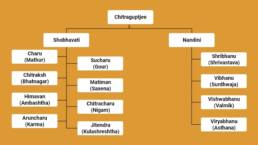KAYASTHAS
WHO KAYASTHAS ARE
Kayasthas have historically occupied the highest government offices, serving as ministers and advisors during early medieval Indian kingdoms and the Mughal Empire, and holding important administrative positions during the British Raj. With the passing of time, the Kayasthas have surged ahead. They have broken new grounds in vocations other than those relating to writing and record-keeping and excelled in them.
Thus, in public life, Dr. Rajendra Prasad rose to become the first President of the Republic of India, whereas Lal Bahadur Shastri succeeded Jawaharlal Nehru as the Prime Minister. Dr. Sampuranand was the Chief Minister of U.P. and Governor of Rajasthan, besides being a literary figure.
Thus, in public life, Dr. Rajendra Prasad rose to become the first President of the Republic of India, whereas Lal Bahadur Shastri succeeded Jawaharlal Nehru as the Prime Minister. Dr. Sampuranand was the Chief Minister of U.P. and Governor of Rajasthan, besides being a literary figure.
Jaya Prakash Narain brought down Indira Gandhi, and Subhas Chandra Bose fought the British rule militarily. Shanti Swarup Bhatnagar and Jagdish Chandra Bose were eminent scientists. Munshi Prem Chand, Harivansh Rai Bachchan, Raghupat Sahai "Firaque" Gorakhpuri, Dr. Vrindavan Lal Verma, Dr. Ram Kumar Verma, and Dr. Dharm Vir Bharti have been men of letters. Swami Vivekanand was a philosopher and a true Indian. Amitabh Bachchan and Shatrughan Sinha have excelled in the film world, and Mukesh and Sonu Nigam in the world of music.
WHERE KAYASTHAS ARE FROM
Kayasthas mostly belong to the Hindi-speaking states of Uttar Pradesh, Bihar, Madhya Pradesh, Delhi, West Bengal, Orissa and Assam. Kayasthas also migrated to various other parts of the country. Most of the Kayasthas who shifted to Hyderabad from Delhi and Uttar Pradesh in the middle of the eighteenth century got employment in the court of the Nizam.
The maps below illustrate their geographical spread:
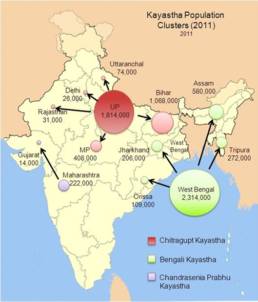
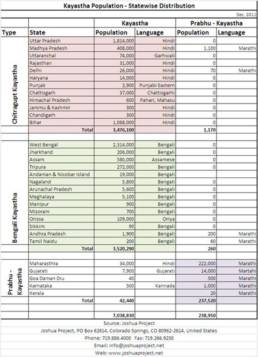
Largest States (only 15 largest shown) World Population= 9,716,000
ASPECTS OF CULTURE
a.Endogamy:
Kayasthas practice family exogamy and caste endogamy preferring to marry only within their sub-castes. Individuals of the same Al may not intermarry, while those of the same caste and different Als can. Thus, an individual from the Srivastava sub-caste and Pandey Al should not marry another Pandey of the same sub-caste but can marry an individual belonging to another Al of the same subcaste. Though it was a widely practiced old tradition it has lost its significance in modern times to a great extent.
Kayasthas practice family exogamy and caste endogamy preferring to marry only within their sub-castes. Individuals of the same Al may not intermarry, while those of the same caste and different Als can. Thus, an individual from the Srivastava sub-caste and Pandey Al should not marry another Pandey of the same sub-caste but can marry an individual belonging to another Al of the same subcaste. Though it was a widely practiced old tradition it has lost its significance in modern times to a great extent.
b.Worship:
Kayasthas worship all Hindu Gods and celebrate all festivals like Holi, Diwali, etc like any Hindu anywhere in the world, with the same faith and devotion. In addition to the above, the Kayasthas worship Shree Chitraguptaji and on Bhai-Dooj, they celebrate Kalam-Dawaat Pooja (pen, inkpot, and sword worship), a ritual in which pens, papers, and books are worshipped. This is the day when Shree Chitraguptji was created by Lord Bramha and Yamaraj got relieved of His duties and used this leave to visit His sister Devi Yamuna; hence the whole world celebrates Bhai-Dooj on this day and the Kayastha celebrate Shree Chitraguptajayanti, i.e. the 'Birthday' of their progenitor.
Kayasthas worship all Hindu Gods and celebrate all festivals like Holi, Diwali, etc like any Hindu anywhere in the world, with the same faith and devotion. In addition to the above, the Kayasthas worship Shree Chitraguptaji and on Bhai-Dooj, they celebrate Kalam-Dawaat Pooja (pen, inkpot, and sword worship), a ritual in which pens, papers, and books are worshipped. This is the day when Shree Chitraguptji was created by Lord Bramha and Yamaraj got relieved of His duties and used this leave to visit His sister Devi Yamuna; hence the whole world celebrates Bhai-Dooj on this day and the Kayastha celebrate Shree Chitraguptajayanti, i.e. the 'Birthday' of their progenitor.
By worshipping Chitragupta who is their ancestor, Kayasthas have the singular distinction of being the only "Ancestor-worshipping" sect of Hinduism.
By worshipping Chitragupta who is their ancestor, Kayasthas have the singular distinction of being the only "Ancestor-worshipping" sect of Hinduism.
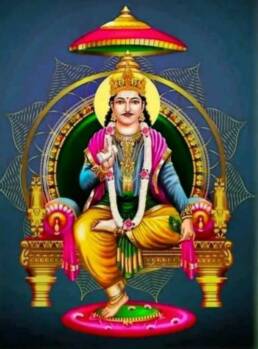
(Shri Chitragupt Ji Maharaj , Image Courtesy - Internet)
c.Food
Unlike most Baniya (Vaishya) or Brahmins, and like Kshatriyas, Kayasthas eat onions, garlic, meats like mutton and chicken, fish, and eggs, though a large number are also vegetarians. Meat-eating Kayasthas do not eat beef as the cow is considered sacred for Hindus.
Unlike most Baniya (Vaishya) or Brahmins, and like Kshatriyas, Kayasthas eat onions, garlic, meats like mutton and chicken, fish, and eggs, though a large number are also vegetarians. Meat-eating Kayasthas do not eat beef as the cow is considered sacred for Hindus.
It is believed though not yet proved that Kayasthas of holy towns like Prayag, Mathura, Varanasi, etc. are pure vegetarians, while in other areas they may be mixed. It is said that Kayasthas started eating meat during the Muslim period when they socially mixed with the Muslims.
It is also said that Kayasthas have the best eating sense because, amongst Hindus, Kayasthas add the largest varieties of food to their diet. Kayastha Cuisine is distinct in its uses of spices and radically different styles of cooking and various recipes are favourites of Michelin star chefs around the world.
d.Social
Of all the other castes in India, Kayasthas are the easiest to mingle with other castes. They did this when the Muslims came to India, and modern examples of this are Kayasthas outside India where they mingle with other castes more than they mingle among themselves.
This cosmopolitan outlook distinguishes members of this caste, and along with the great emphasis on education, is to a large extent responsible for their success in changing times.
HISTORY
Kayastha ministers find mention in Hindu mythology. Prior to the Raghuvanshis , Ayodhya was ruled by the progeny of Chitragupta.
The Kayastha who are represented by the "Kayats" or the hereditary caste of the scribes of the present day, formed originally a sub-military class. The Anthropological Survey of India conducted a survey during the British Raj which concluded that the Kayastha community was influential during the Mauryan period as administrators.
Also, much proof has been found that the Hindu Kings used to grant lands to the Kayasthas, a practice enjoyed only by a particular caste. Also, it is logical to consider the status of the Kayasthas when Sanskrit was the state language under the Hindu Kings.
Kayasthas have the unique distinction of having a script – Kaithi, associated with their name. Kaithi (also known earlier as Kayati, Kayathi, or Kayasthi), like Dev Nagri, was used mainly by Kayasthas in northern India. It has its own Unicode now.
The Kayastha was one of the most influential Castes in Kashmiri politics around the 7th century (ref. Rajatarangini). The economic status of the Kayastha community bettered than that of other castes when the Muslims conquered India. Other Indian castes would typically not find employment under the Muslim rulers, as they could not learn the Muslim languages of Persian, Arabic, and later Urdu. On the other hand, the Kayastha community traditionally put a lot of emphasis on education and prospered during the Islamic period in India.
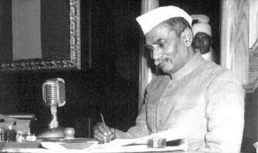
a.Classical India:
Rajendra Prasad, who went on to become the first president of India, alongside Jawaharlal Nehru and Bhulabhai Desai at the All India Congress Committee Session in April 1939 quoted Brahmanical religious texts which refer to Kayasthas as a caste responsible for writing secular documents and maintaining records from the 7th century AD onward. According to the historical chronicle known as the Rajatarangini ("River of Kings"), written by Kalhana in the 12th century AD, Kayasthas served as prime ministers and treasury officials under several Kashmiri kings.
Prior to the 13th century AD, during the rule of Hindu kings, Kayasthas dominated public service and had a near-monopoly on appointments to government positions. They may also have been described as Karanas, since the two groups performed similar functions.
In Bengal, during the reign of the Gupta Empire beginning in the 4th century AD, when systematic and large-scale colonization by Aryan Kayasthas and Brahmins first took place, Kayasthas were brought over by the Guptas to help manage the affairs of state.
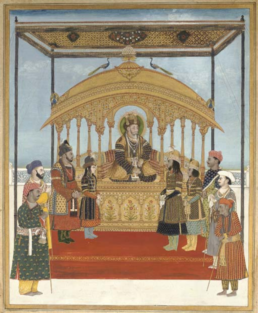
b.Medieval India
After the Muslim conquest of India, Kayasthas mastered Persian, which became the official language of the Mughal courts. According to Abu al-Fazl, Emperor Akbar's prime minister, Kayasthas were rulers of the Pala Empire, one of the major early medieval Indian kingdoms that originated in Bengal.
One of the most notable Kayasthas of the Mughal period was Raja Todar Mal, Emperor Akbar's finance minister and one of the court's nine Navaratnas, who is credited with establishing the Mughal revenue system. He also translated the Bhagavata Purana from Sanskrit into Persian.
Raja Todar Mal was born on 1st January 1500, in the city of Laharpur, (district Sitapur) in present-day Uttar Pradesh from where many Kayasthas come and have traditionally been employed in civil services of kings much before Akbar's time. Some historians considered him to be either a Khatri or Agarwal, debate on which remains unresolved.
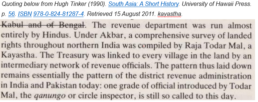
Another renowned Kayastha of those times was Raja Birbal (born Mahesh Das Brahmbhatt in 1528 in Kalpi, Uttar Pradesh). He was an advisor and main commander (Mukhya Senapati) of an army in Akbar’s court and one of his Navratna.
He is mostly known in the Indian subcontinent for the Folk Tales which focus on his wit. Educated in Hindi, Sanskrit, and Persian, Birbal wrote prose and specialized in music and poetry in the Braj language, thus gaining fame. In 1582 he adopted Din-iIlahi, a religion propounded by Akbar. He died in 1586.
Another renowned Kayastha of those times was Raja Birbal (born Mahesh Das Brahmbhatt in 1528 in Kalpi, Uttar Pradesh). He was an advisor and main commander (Mukhya Senapati) of an army in Akbar’s court and one of his Navratna.
He is mostly known in the Indian subcontinent for the Folk Tales which focus on his wit. Educated in Hindi, Sanskrit, and Persian, Birbal wrote prose and specialized in music and poetry in the Braj language, thus gaining fame. In 1582 he adopted Din-iIlahi, a religion propounded by Akbar. He died in 1586.
In Bengal, Kayasthas had been the dominant landholding caste prior to the Muslim conquest and continued this role under Muslim rule. Indeed, Muslim rulers had from a very early time confirmed the Kayasthas in their ancient role as landholders and political intermediaries.
Bengali Kayasthas served as governors, prime ministers, and treasury officials under the Mughal rule. As a result of their exalted status amongst Muslim sultans, many Bengali Kayasthas became zamindars and Jagirdars. According to Abu al-Fazl, most of the Hindu zamindars in Bengal were Kayasthas. Maharaja Pratapaditya, the King of Jessore who declared independence from the Mughal rule in the early 17th century, was a Kayastha.
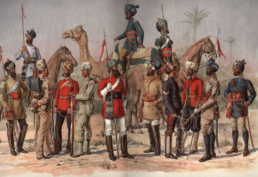
c.British India
During the British Raj, Kayasthas continued to proliferate in public administration, qualifying for the highest executive and judicial offices open to Indians. Bengali Kayasthas took on the role occupied by merchant castes in other parts of India and profited from business contacts with the British. In 1911, for example, Kayasthas and Brahmins owned 40% of all the Indian-owned mills, mines, and factories in Bengal.
Some of the significant figures of the Indian independence movement were Kayasthas, including the spiritual leaders - Swami Vivekananda and Sri Aurobindo, and the revolutionary leader Subhas Chandra Bose.

d.Modern India
The Kayasthas are found mostly in central, eastern, and northern India, particularly in Bengal. Today, there are an estimated 800,000 Kayasthas in India. Kayasthas that have risen to prominence since independence includes the country's first president, Rajendra Prasad, and its second prime minister, Lal Bahadur Shastri. Glimpses of Kayastha luminaries and their achievements are aptly depicted in this video, the link is given below: https://youtu.be/9ISHYNOFLu4
GENEALOGY
The Kayasthas trace their genealogy to Lord Chitragupta. According to Hindu Vedic Scriptures and Hindu Mythology, the world was created by Brahma, the Creator. Lord Brahma first created 16 Sons from various parts of his own body. Chitragupt Ji, his 17th creation, is believed to be created from Lord Brahma’s Mind & Soul (Kaya).
Shree Chitragupt Ji is a divine incarnation in human form and is called Kayastha since he is the only creation of Lord Brahma who was created in entirety (kaya) from the Lord's body, unlike the other 16 sons who were created only from various parts of the body. Shree Chitragupt Ji (and hence the Kayastha) were accorded a dual-caste status, namely Kshatriya (Warrior) and Brahmin (The Learned).
According to the scriptures, Lord Brahma went into meditation for 11,000 years and when he opened his eyes, he saw a man holding a pen and ink-pot in his hands, as well as a sword girdled to his waist. Lord Brahma spoke: “Thou hast been created from my body (Kaya); therefore, shall thy progeny be known as the Kayasthas. Thou hast been conceived in my mind (Chitra) and in secrecy (Gupta); thy name shall also be Chitragupta Ji.”
Brahma then enjoined him to dispense justice and punish those who violated the dharma. Thus, the Kayasthas were accorded a dual caste, Brahman/Kshatriya. In the legends of Chitragupta Ji as well as in the Vedas, he is referred to as the greatest king, while the rest are "Rajakas," or little kings.
चित्र इद राजा राजका इदन्यके यके सरस्वतीमनु ।
पर्जन्य इव ततनद धि वर्ष्ट्या सहस्रमयुता ददत ॥ RIG VEDA Book 8/ Hymn 21/ Stanza 18
पर्जन्य इव ततनद धि वर्ष्ट्या सहस्रमयुता ददत ॥ RIG VEDA Book 8/ Hymn 21/ Stanza 18
In the Garud Purana, Chitragupta is hailed as the first man to give the script. “ Chitragupta namastubhyam vedaksaradatre” (Obeisance to Chitragupta, the giver of letters)
a)Temples:
There are several temples in India, particularly in South India, enshrining the Lord Chitragupta. The most famous of them is located at Kanchipuram and one of the ancient temples of Chitragupta Ji is situated in Khajuraho.
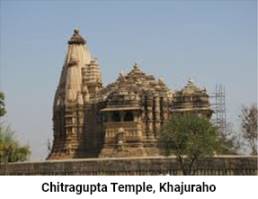
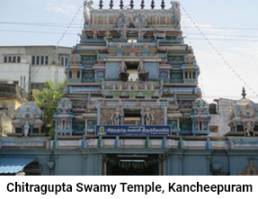
b)The Family Tree:
Shree Chitragupta Ji married Devi Nandani and Devi Shobhavati and had twelve divine Sons. The 12 Sons started the 12 main branches of Brahma Kayastha.
The 12 clans of Brahma Kayastha are:
Mathur Gour Bhatnagar Saxena Ambashtha Nigam Karna Kulshreshtha Srivastava Surdhwaja Valmiki Asthana
